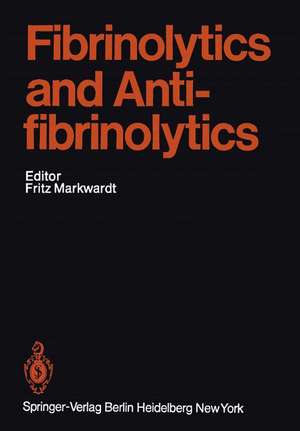Fibrinolytics and Antifibrinolytics: Handbook of Experimental Pharmacology, cartea 46
Editat de Fritz Markwardt Contribuţii de B. Blombäck, P.C. Comp, P.D. Desnoyers, F. Duckert, U. Hedner, K.N.v. Kaulla, H.P. Klöcking, M. Kopec, H. Landmann, Z.B. Latallo, F. Markwardt, I.M. Nilsson, M. Pandolfi, K.C. Robbins, W.E. Roschlau, K. Stocker, F.B. Taylor, G. Vogelen Limba Engleză Paperback – 13 dec 2011
Din seria Handbook of Experimental Pharmacology
- 5%
 Preț: 3517.78 lei
Preț: 3517.78 lei - 5%
 Preț: 1425.97 lei
Preț: 1425.97 lei - 5%
 Preț: 1435.28 lei
Preț: 1435.28 lei - 5%
 Preț: 1430.52 lei
Preț: 1430.52 lei - 5%
 Preț: 1930.69 lei
Preț: 1930.69 lei - 5%
 Preț: 1922.47 lei
Preț: 1922.47 lei - 5%
 Preț: 1937.46 lei
Preț: 1937.46 lei - 5%
 Preț: 2117.58 lei
Preț: 2117.58 lei - 5%
 Preț: 2119.96 lei
Preț: 2119.96 lei - 5%
 Preț: 2117.38 lei
Preț: 2117.38 lei - 5%
 Preț: 1088.15 lei
Preț: 1088.15 lei - 5%
 Preț: 1098.27 lei
Preț: 1098.27 lei - 5%
 Preț: 1420.29 lei
Preț: 1420.29 lei - 5%
 Preț: 1104.84 lei
Preț: 1104.84 lei - 5%
 Preț: 1104.84 lei
Preț: 1104.84 lei - 5%
 Preț: 1108.14 lei
Preț: 1108.14 lei - 5%
 Preț: 1106.69 lei
Preț: 1106.69 lei - 5%
 Preț: 1105.77 lei
Preț: 1105.77 lei - 5%
 Preț: 1174.35 lei
Preț: 1174.35 lei - 5%
 Preț: 408.48 lei
Preț: 408.48 lei - 5%
 Preț: 409.63 lei
Preț: 409.63 lei - 5%
 Preț: 539.89 lei
Preț: 539.89 lei - 5%
 Preț: 720.47 lei
Preț: 720.47 lei - 5%
 Preț: 733.09 lei
Preț: 733.09 lei - 5%
 Preț: 731.27 lei
Preț: 731.27 lei - 5%
 Preț: 746.43 lei
Preț: 746.43 lei - 5%
 Preț: 747.72 lei
Preț: 747.72 lei - 5%
 Preț: 725.24 lei
Preț: 725.24 lei - 5%
 Preț: 742.80 lei
Preț: 742.80 lei - 5%
 Preț: 393.23 lei
Preț: 393.23 lei - 5%
 Preț: 735.66 lei
Preț: 735.66 lei - 5%
 Preț: 728.33 lei
Preț: 728.33 lei - 5%
 Preț: 389.52 lei
Preț: 389.52 lei - 5%
 Preț: 730.71 lei
Preț: 730.71 lei - 5%
 Preț: 740.58 lei
Preț: 740.58 lei - 5%
 Preț: 730.19 lei
Preț: 730.19 lei - 5%
 Preț: 723.42 lei
Preț: 723.42 lei - 5%
 Preț: 731.27 lei
Preț: 731.27 lei - 5%
 Preț: 726.68 lei
Preț: 726.68 lei - 5%
 Preț: 3516.49 lei
Preț: 3516.49 lei - 5%
 Preț: 729.26 lei
Preț: 729.26 lei - 5%
 Preț: 737.11 lei
Preț: 737.11 lei - 5%
 Preț: 730.92 lei
Preț: 730.92 lei - 5%
 Preț: 738.78 lei
Preț: 738.78 lei - 5%
 Preț: 909.94 lei
Preț: 909.94 lei - 5%
 Preț: 720.10 lei
Preț: 720.10 lei - 5%
 Preț: 734.74 lei
Preț: 734.74 lei - 5%
 Preț: 727.80 lei
Preț: 727.80 lei - 5%
 Preț: 3513.38 lei
Preț: 3513.38 lei
Preț: 742.04 lei
Preț vechi: 781.08 lei
-5% Nou
Puncte Express: 1113
Preț estimativ în valută:
141.99€ • 148.65$ • 117.49£
141.99€ • 148.65$ • 117.49£
Carte tipărită la comandă
Livrare economică 05-19 aprilie
Preluare comenzi: 021 569.72.76
Specificații
ISBN-13: 9783642668654
ISBN-10: 3642668658
Pagini: 684
Ilustrații: XXII, 656 p.
Dimensiuni: 170 x 244 x 36 mm
Greutate: 1.07 kg
Ediția:Softcover reprint of the original 1st ed. 1978
Editura: Springer Berlin, Heidelberg
Colecția Springer
Seria Handbook of Experimental Pharmacology
Locul publicării:Berlin, Heidelberg, Germany
ISBN-10: 3642668658
Pagini: 684
Ilustrații: XXII, 656 p.
Dimensiuni: 170 x 244 x 36 mm
Greutate: 1.07 kg
Ediția:Softcover reprint of the original 1st ed. 1978
Editura: Springer Berlin, Heidelberg
Colecția Springer
Seria Handbook of Experimental Pharmacology
Locul publicării:Berlin, Heidelberg, Germany
Public țintă
ResearchCuprins
The Fibrinolytic Process.- Biochemistry of the Factors of the Fibrinolytic System.- Fibrinogen and Fibrin Formation.- Fibrinogen and Fibrin Degradation Products.- The Measurement of Fibrinolytic Activities.- Activators of Fibrinolysis.- Biochemistry of Streptokinase.- Pharmacology of Streptokinase.- Clinical Use of Streptokinase.- Urokinase.- Synthetic Fibrinolytic Agents. Induction of Fibrinolytic Activity In Vitro.- Indirect Fibrinolytic Agents.- Fibrinolytically Active Enzymes.- Plasmin.- Fungal Proteases.- Defibrinogenation with Thrombin-like Snake Venom Enzymes.- Antifibrinolytics.- Naturally Occurring Inhibitors of Fibrinolysis.- Synthetic Inhibitors of Fibrinolysis.- Author Index.






